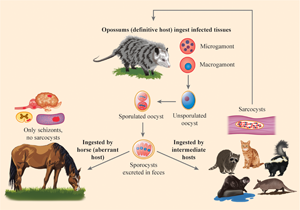Article contents
Sarcocystis neurona, Neospora spp. and Toxoplasma gondii infections in horses and equine protozoal myeloencephalitis (EPM): five decades of personal experience, perspectives and update
Published online by Cambridge University Press: 09 March 2022
Abstract

Sarcocystis neurona, Neospora spp. and Toxoplasma gondii are related protozoans; they were considered the same parasite until 1970s. Two of these parasites, S. neurona and Neospora spp. are associated with a neurological syndrome in horses, called equine protozoal myeloencephalitis (EPM). The diagnosis and treatment of EPM are difficult. Most cases of EPM are related to S. neurona while only a few are due to Neospora spp. infections. There are two species of Neospora, Neospora caninum that has a wide host range and Neospora hughesi that has been found only in horses. Currently, T. gondii is not considered as a cause of EPM in horses, although it causes neurological illness in many other hosts, including humans. The present review provides an update on history, life cycle, diagnosis and treatment of these three infections in horses.
- Type
- Review Article
- Information
- Creative Commons
- This is a work of the US Government and is not subject to copyright protection within the United States. Published by Cambridge University Press.
- Copyright
- Copyright © United States Department of Agriculture, [2022]
Footnotes
*Dedicated to the memory of Dr William J. Saville, late professor, Department of Veterinary Preventive Medicine, The Ohio State University, Columbus, Ohio, USA, for his contributions to EPM.
References
- 3
- Cited by





